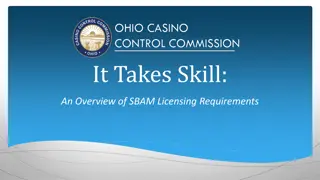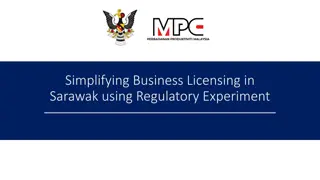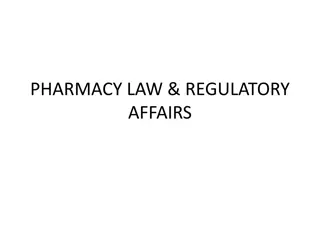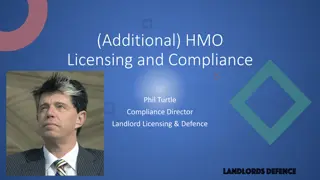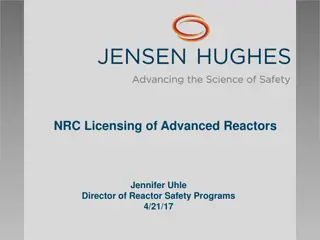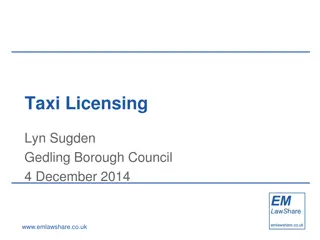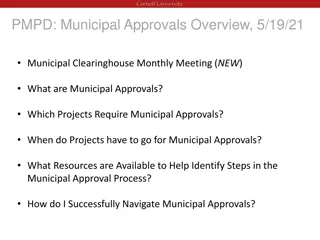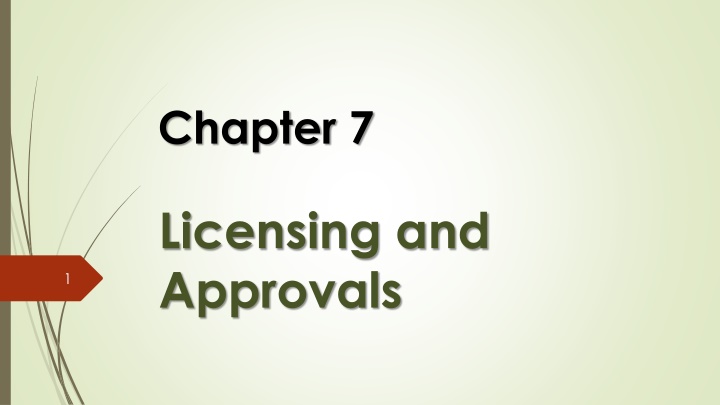
Safety Oversight and Licensing Procedures in Aviation
Explore the essential functions of an ATM/SAR oversight organization, State safety management responsibilities, and the role of licensing in ensuring aviation personnel meet requirements before performing critical safety functions. Dive into the licensing process, personnel licensing functions, and licensing of air traffic controllers, emphasizing training, assessment, and supervision. Gain insights on audits, competency evaluation, and safety oversight tools for ensuring compliance and safety in the airspace system.
Download Presentation

Please find below an Image/Link to download the presentation.
The content on the website is provided AS IS for your information and personal use only. It may not be sold, licensed, or shared on other websites without obtaining consent from the author. If you encounter any issues during the download, it is possible that the publisher has removed the file from their server.
You are allowed to download the files provided on this website for personal or commercial use, subject to the condition that they are used lawfully. All files are the property of their respective owners.
The content on the website is provided AS IS for your information and personal use only. It may not be sold, licensed, or shared on other websites without obtaining consent from the author.
E N D
Presentation Transcript
Chapter 7 Licensing and Approvals 1
Objectives 2 At the end of this course the participant should be able to: Describe the functions of an ATM/SAR oversight organization; Demonstrate an understanding of State safety management responsibilities; Highlight an ATM/SAR inspector s role within the ATM oversight organization; State the duties and responsibilities an ATM/SAR inspector; Describe the required ATM & SAR inspector training and competencies; Develop safety oversight tools for oversight of ATM & SAR providers; Perform an audit of an ATS & SAR service provider; Write and disseminate an audit report; List requirements for licensing/Competency of ATM personnel; Describe reviews and approvals of proposed changes to the airspace system; Develop technical guidance material.
Licensing 3 Licenses permit aviation personnel to perform certain critical safety functions, such as providing air traffic control services. They ensure that individuals and organizations performing an aviation activity meet the established requirements before they are allowed to exercise the privileges of a licence, certificate, authorization or approval to conduct the relevant aviation activity.
Personnel Licensing 4 Essential licensing functions include: Writing and amending requirements related to the training and licensing of aviation personnel; Assessment and approval of applications for licenses and ratings and the issue of licenses and ratings; Application of medical fitness assessments relating to license requirements; Approval, designation, and supervision of individuals or organizations delegated to perform specific tasks on behalf of the personnel licensing office.
Licensing of Air traffic Controllers 5 ATM/SAR inspectors are involved in the safety oversight of licenses issued to ATS & SAR personnel. The ATM/SAR inspector may conduct audits related to ATS provider s compliance with licensing requirements, as well as recommend suspension, revocation, or reinstatement of licenses. Training enables controllers to achieve new qualifications that may need variation of their licenses and hence requires oversighting. The ATM/SAR inspector therefore has to evaluate the ATS provider s training program and competency schemes.
Licensing of Air traffic Controllers 6 The ATM & SAR service provider is responsible for maintaining an organization with competent personnel, procedures, facilities and equipment that are necessary for the provision of ATS/SAR and the development of instrument flight procedures. The Licenses are valid for a limited duration and must be renewed at regular intervals as specified in regulations.
Licensing of Air traffic Controllers 7 The licensing program for ATS/SAR service provider personnel includes: Training validation Proficiency assessment and qualification (skills check) Medical evaluation Specific ratings/endorsements for the following functions: Air traffic controller ratings: Aerodrome control rating Aerodrome control surveillance rating Approach control procedural rating Approach control surveillance rating Approach precision radar control rating Area control procedural rating Area control surveillance rating
Approvals 8 Apart from licensing ANSP safety personnel and ATCOs the ATM/SAR inspector responsibilities include: establishing, approving, and accepting safety standards for ATS & SAR, monitoring the ATS provider s compliance with established safety standards and the approved SMS.
ANSP Document Review and Approval 9 The ATS provider shall be required to prepare and have approved by the authority a manual of operations. The Manual of Operations shall contain all information and instructions necessary to enable the air traffic services provider s personnel perform their duties. Amendments may be made to the manual of operations so as to maintain the accuracy of the information in the manual of operations whenever: (a) The ATS provider deems it necessary to amend the manual; or, (b) The Authority issues a written directive requiring the ATS provider to alter or amend the manual. The holder of a certificate shall submit the proposed amendment to the Authority for approval.
ANSP Document Review and Approval 10 Documentation reviews will be conducted in a standardized manner to ensure approvals to changes are done the same way every time. Reviews may be conducted by: an individual ATM/SAR inspector for simple and/or straightforward changes, or; a team of subject matter experts may be required for more complex changes.
ANSP Document Review and Approval 11 The approval process shall be done as follows: Figure 1: Document review and approval process
Air Navigation Systems 12 An ATS/SAR provider s decisions to acquire or implement new systems or new/changed services must be in accordance with the provisions established by the regulator and the ATS provider s SMS manual. A proposed change will be approved/accepted if it is found to be in accordance with applicable requirements. The ATS/SAR provider must validate and verify the safety requirements identified during the SRM process before deployment and full operational use. Any new systems must also be evaluated by the ATS/SAR provider in the case of hazard or system failure. All new or changed procedures are to be developed in accordance with appropriate CAA policies and the SMS. Changes will be approved by the relevant oversight organization.
Changes to the air navigation system 13 Any changes proposed to the ATM & SAR system must be reviewed and evaluated before being accepted/approved by the Authority. This action is required prior to the proposed changes being implemented. Changes to the following items require approval by the ATM & SAR oversight department: Operating procedures Training programmes Hours of operations Manual of operations Airspace system Separation standards safety management systems etc.
Changes to the air navigation system 14 The ATM/SAR oversight agency should establish a process for review and approval or disapproval of changes to the airspace system, air traffic control separations standards, ATS provider s SMS manual(s), and Training and proficiency standards. ATS providers must document proposed changes to the airspace system in a safety assessment, or safety case. A safety case: Proposes a change to the aviation system; Presents a rationale justifying why the change should be approved Is evidence-based; and Must comply with the approved SMS manual.
ATS/SAR System Changes 15 The ATM/SAR inspectorate will review and approve the ATS provider s safety implementation actions, risk assessment techniques, and risk management strategies for any changes, including those at the local level, before the ANSP can implement changes to the airspace system. An ATS provider must develop and implement a safety status reporting program consistent with its internal review of programs to provide the ATM/SAR inspectorate insight into airspace system changes. In addition, the ATM/SAR inspectorate will review and approve ATS provider s safety risk management strategies for future systems.
Air Traffic Separation Standards 16 The ATM/SAR inspectorate will also review and approve proposed changes to air traffic separation standards. As part of this process, safety data should be compared to past baselines..
SMS Changes 17 The ATM/SAR inspectorate approves the existing ATS provider s SMS(s) and associated manual(s). Accordingly, ATM/SAR inspectorate safety oversight efforts are focused on changes to and deviation from the existing SMS. An ATS provider must conduct risk assessments in accordance with the provisions of the SMS manual. Risk assessments must include a plan to evaluate identified safety critical parameters during initial operational implementation and after it is complete. If a high initial or residual risk hazard is identified in the safety risk assessment the ATS provider must mitigate it under controls approved by the ATM/SAR inspectorate. The ATM/SAR inspectorate will also approve the ANSP s process for mitigation of medium and low-risk hazards.
Acceptance 18 The process whereby the ATS oversight organization has delegated the authority to the ATS provider to make changes within the confines of approved standards and only requires the ATS provider to notify the regulator of those changes within 30 days. Changes made by the ATS provider in accordance with their delegated authority can be made without prior approval by the ATS oversight organization. Medium-risk hazards may be accepted under the condition that the ATS provider will track identified hazards in a database that the ATM/SAR inspectorate can continuously access.
Training and Proficiency Standards for ATS Provider s Personnel 19 An ATS provider may not use any person or provider to perform direct safety-related air traffic control services unless the person performing the work is appropriately qualified, properly trained, certificated, and authorized to do so in accordance with the ATS Provider s policies, manuals, and any oversight programs. Additionally, an ATS provider is responsible for providing any appropriate training (including providing facilities, materials and instructors) needed for personnel to be fully informed on procedures, techniques, and new equipment in use. The ATM/SAR inspectorate will approve changes the ATS provider makes to training and proficiency of its personnel related to air traffic control functions.
Training and Proficiency Standards for ANSP Personnel 20 All ATS Provider s(s) operations must be performed in accordance with appropriate CAA/Authority manuals and directives and regulations. An ATS Provider is expected to prepare and keep current materials on procedures, standards, and processes for the provision of air traffic control services. The ATS provider may be delegated the authority to make changes to those materials, within existing standards, after initial approval by the ATM/SAR inspectorate.
Exercise 4 Case study and Discussion Case study and Discussion (Group) (Group) 21


